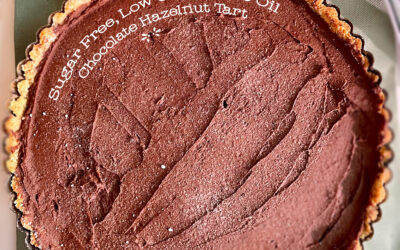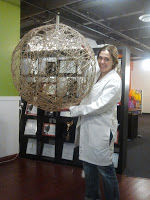
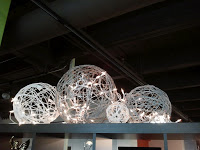
Pinterest is awash with various people pinning tangle balls. Tangles made from string, from yarn, from twine, from bamboo strips and from wire. They are often used in DIY lighting or decorative accents and can be made super big to very small.
We decided to do a little spruce up at our office recently, and I had my eye on this kind of project for a bit. Our agency logo includes a “tangle”, and I thought it would be fun to create various sizes around the office in a decorative manner, lighting them with string lights to brighten certain corners.
So after two weeks of smelling like fabric stiffener and Vaseline (I know, that sounds attractive!) I certainly can give you the low down on what works best for what, and some tips I learned along the way.
But first, how to do this.
What you will need:
Round balls you can inflate/deflate in the sizes you want.
(I used a variety of things, from small blow up balls to a super-large beach ball to various balloons to some “punch” balloons.)
Bottles of Fabric Stiffener like “STIFFY”
A Tupperware container you can throw away
Vaseline or nonstick cooking spray
Yarn, natural twine or cotton string
Tarp
A pump (if you want a really big tangle)
Paper towels
Scissors
Spray paint (if wanting a different color)
How to do it:
1: Cover your area with a tarp. This is very messy endeavor. Also, wear paint clothes or a smock.
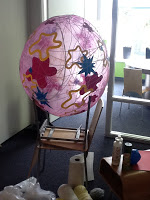
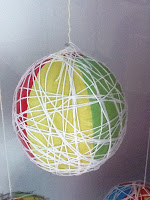
2: It is best to hang medium sized balls in an empty closet to sit overnight. SO tie a piece of yarn to the blow hole closure and leave enough length to tie it on a hanger or rod. If you are making a HUGE ball, this is tricky. We found that if we flipped a small chair on top of another one, and used the legs as a “holder” for the ball from the bottom, the ball could sit in the legs and be left alone to dry overnight before the next layer. We just had to keep rotating this around all week as we added layers to it. If using chairs in this way, I would suggest you cover those with a thin plastic tarp as well.
3: Cover your inflated ball lightly with Vaseline or with cooking spray. I found the cooking spray to be easier to deal with, but the Vaseline had more staying power on the ball, as I reused the balls over and over again throughout the week.
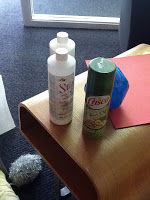
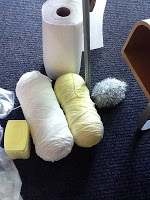
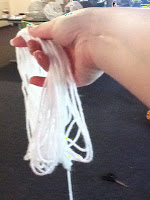
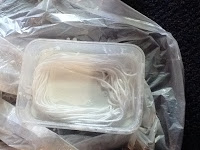
4: Either tie off your ball to work on it while hanging (I found I had less control this way, as the ball kept twirling in the opposite direction if I Lost hold of it and unwound itself) or work on it on the tarp on the floor. Pull out a long piece of string/twine/yarn. As you unwind it, loosely make loops around your hand to keep things organized and untangled. Get a good amount around your hand that you can handle without having it be too wily. (You will do more than one layer). Cut the yarn when you have enough. Now pour about ¼ cup or more of fabric stiffener in the plastic container. Lay the looped yarn flat into the glue, but keep it in the loop. Press it into the glue, move it around until it is well saturated. Keeping it in the loop, pull it out and let it drip. With your fingers and hand, keep the loop shape but squeeze excess glue, but not too much. If you squeeze too much out, it will not be stiff enough. Now put your hand through the loop and with the dangled extra string, begin laying and wrapping the string around the ball. Doing it this way will keep the string organized and not a tangled mess. It still may happen, but doing it this way (I found the hard way) it is less likely. Tie off your end piece to another are of string. Let sit for 10 minutes as you repeat this step for another layer. I try and see where gaps and holes are.
5: Keep layering until you have a thick structure. If the tangles plan on sitting, they will need to hold their own weight. This will mean a lot of layers. Also, if using a beach ball, you will need a whole big enough to pull the ball through once deflated. SO keep that in mind as you layer.
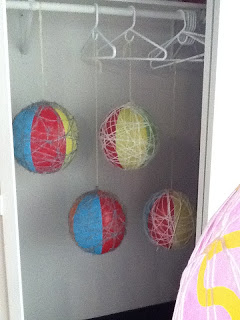
6: Once done, let sit overnight to dry and cure completely. For the very large tangle, I would continue to layer after sitting overnight.
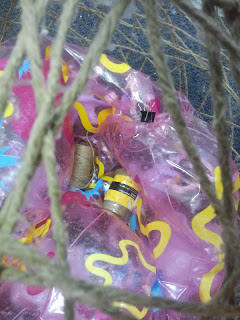
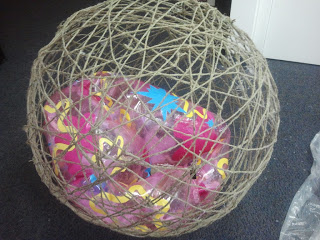
7: Now, the tricky part-deflating. If using a balloon, it’s easy. Just puncture where you tied it with a thin needle to make a small hole. It will slowly deflate on it’s own. You can then easily pull it out of one of the yarn holes. For some of the beach balls, you need to either 1) get your hands in their, squeeze the plastic blowing area so it releases air as you use your other hand to add pressure to the ball to deflate. Then pull the plastic out through the biggest hole. I realized after a few of these that my hands were causing the balls to distort in places. SO for the big one, I took a binder clip to the plastic blowing area so it is being squeezed together passively. I then threw a small ball of twine on the ball to add weight gently so it deflated slowly without much handling. Every once in awhile, I would move things in there and reposition the “weight”. After about an hour, the ball was deflated enough for me to simple pull out.
8: At this point, I found clear acrylic shellac to keep things stiff is a nice finish, or spray-painting them as well. We strung white Christmas lights through parts of them, but not through the whole tangle. The fact is, we found that the string lights were way too heavy for the tangles, and they collapsed after a few days. SO when we strung them, we kept them through the bottom just delicately to add some sparkle.
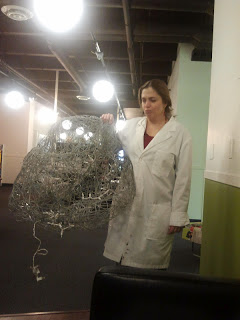
MATERIAL NOTES:
WE found the hard way that the best material that stays the stiffest-especially for the really big tangles is the most untreated material. That would be natural twine. It seems to suck up the stiffener the most and dry the strongest. We tried fashion eyelash yarn or some texture, and that pretty much was a disaster. We used regular white yarn that worked only if it was a smaller tangle and had many layers to the structure. You can play with other string, too. But my recommendation is that if you want it large and to hold it’s own weight, use something as untreated and raw as possible. Some yarns have dyes and chemical additives that may not do what you want it to do.
That’s about it! I am tangled out for a while!
Latest posts by Flora Caputo (see all)
- Sugar-Free, Low-Carb, Olive Oil Chocolate Hazelnut Tart - February 18, 2023
- Easy Slow Cooker French Onion Soup - November 28, 2022
- Recipe: Chicken Vindaloo with Whole Foods Vindaloo Curry Powder - January 22, 2022

